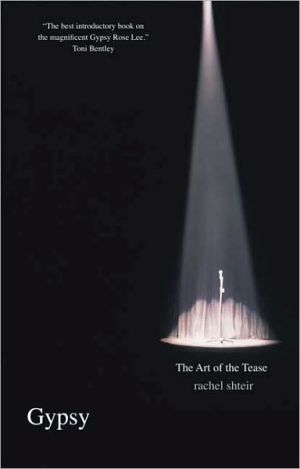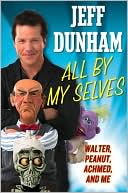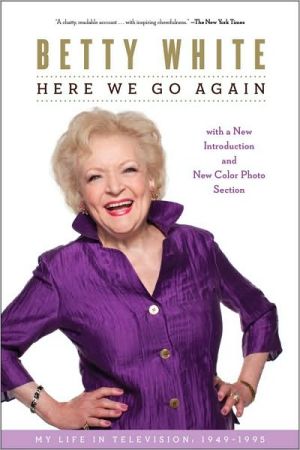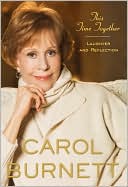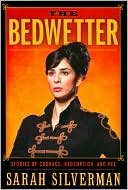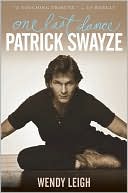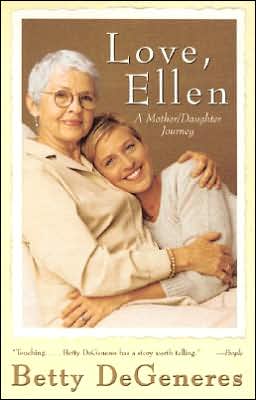Gypsy: The Art of the Tease
A true icon of America at a turning point in its history, Gypsy Rose Lee was the first—and the only—stripper to become a household name, write novels, and win the adulation of intellectuals, bankers, socialites, and ordinary Americans. Her outrageous blend of funny-smart sex symbol with the aura of high culture—she boasted that she liked to read Great Books and listen to classical music while taking off her clothes on-stage—inspired a musical, memoirs, a portrait by Max Ernst, and a species...
Search in google:
A true icon of America at a turning point in its history, Gypsy Rose Lee was the first—and the only—stripper to become a household name, write novels, and win the adulation of intellectuals, bankers, socialites, and ordinary Americans. Her outrageous blend of funny-smart sex symbol with the aura of high culture—she boasted that she liked to read Great Books and listen to classical music while taking off her clothes on-stage—inspired a musical, memoirs, a portrait by Max Ernst, and a species of rose. Gypsy is the first book about Gypsy Rose Lee’s life, fame, and place in America not written by a family member, and it reveals her deep impact on the social and cultural transformations taking shape during her life. Rachel Shteir, author of the prize-winning Striptease, gives us Gypsy’s story from her arrival in New York in 1931 to her sojourns in Hollywood, her friendships and rivalries with writers and artists, the Sondheim musical, family memoirs that retold her history in divergent ways, and a television biopic currently in the making. With verve, audacity, and native guile, Gypsy Rose Lee moved striptease from the margins of American life to Broadway, Hollywood, and Main Street. Gypsy tells how she did it, and why. The Barnes & Noble Review For a stripper who died almost 40 years ago, Gypsy Rose Lee enjoys enviable name recognition. She has the musical Gypsy to thank, of course: the Broadway adaptation of her autobiography, with music by Jule Styne and lyrics by Stephen Sondheim, has made her as immortal as Sky Masterson from Guys and Dolls or Tony and Maria from West Side Story. The downside of this kind of legend, however, is that Gypsy threatens to seem as fictional as those other characters. The reality of the woman who was born Louise Hovick is all the harder to grasp because there is no adequate record of her celebrated routines. No Hollywood studio, in her 1930s heyday, was willing to put a naked stripper on screen.
Gypsy\ THE ART OF THE TEASE \ \ By Rachel Shteir \ YALE UNIVERSITY PRESS\ Copyright © 2009 Rachel Shteir\ All right reserved.\ ISBN: 978-0-300-12040-0 \ \ \ Chapter One\ Undressing the Family Romance \ To Broadway aficionados, the name Gypsy Rose Lee recalls the 1959 eponymous musical (based on her memoir) created by Arthur Laurents, Stephen Sondheim, Jule Styne, and Jerome Robbins. These men saw Gypsy as a victim of Mama Rose, the stage-door mother who forced her daughter into a life of striptease. But the truth about Gypsy is more complicated than anything the musical or the memoir reveals. It is also more complicated than the three memoirs Gypsy's sister and son wrote about their extraordinary relative. No one could invent this woman who tore herself and her profession down at every opportunity. "The stage is 6 feet by 2 feet which is dandy for a coffin but not dandy for me," she complained about the San Francisco nightclub where she stripped in 1941.\ If Gypsy was quick to deride the venues she played in, she was equally quick to apologize after putting on airs. In 1949 the Hollywood columnist Hedda Hopper published a catty remark Gypsy made about the lack of intelligence of a certain "Monkey Girl" in the carnival in which the stripper was then starring. The Monkey Girl writes an angry letter to Hopper, who forwards it to Gypsy. The stripper responded to her friend: "It makes me feellike a heel if I've really hurt her feelings.... She might have an M.A. for all I know."\ The overall arc of Gypsy's life-the bare facts, as it were-is a first-class rags-to-riches story. But the closer you get to that life, the loopier the arc gets-it would have to, as her story itself is a tease. Even something as straightforward as Gypsy's birth date is uncertain. Some sources say that she was born Rose Louise Hovick in 1914, while others list 1911 as the year of her birth. In 1923 a Seattle doctor claimed that Mama Rose altered her birth certificate and that Gypsy was actually born in 1908. All stories about Gypsy's early life do agree that she spent her first years in Seattle in a family of domineering women who had meek or absent husbands, and that as a young child she toured on smalltime vaudeville circuits in the West. She first stripped in 1929, endured vaudeville's death, burlesque's death, Hollywood's humiliation, the Depression, World War II, and television's rise. She produced a Broadway show, wrote two best-selling books (and two flops), toured with her own carnival show, and "retired" in 1959 to tend her garden. And host a TV show. And sell dog food.\ Gypsy borrowed from Edith Wharton and Horatio Alger. She was self-made and aspirational. Her friend Janet Flanner once told her that her brilliance was to understand "as common sense what others regard as downright lunacy." Gypsy's younger sister, June Havoc, described her as having "a comic savagery in her manner." Carson McCullers, who met her in 1940, wrote that she was "witty, kind, very sensible, and utterly true to herself." Gypsy picked up these attributes from spending time alone in her childhood and from hanging around backstage since the age of four and watching her sister and others perform. And from performing herself. And, surely, here the consummate performer and monster whose alias is her mother deserves credit. Here are a few Dickensian tidbits about life with Mother: Rose declined to change her daughters' diapers between dusk and dawn; Rose told June that she tried to abort her; Rose made June "go on with the show" while she was sick with chicken pox and mumps. Later, when Rose pled poverty or cried illness it was prelude to a request for financial consolation. (It should be mentioned, however, that the above stories come from June's pen in her second memoir, in which the younger sister was playing one of her favorite games: "Let's even the score.")\ In the stories about Mother that she began to publish in the mid-1940s, Gypsy tempers Rose's less savory qualities with a fierce maternal dedication. In one, later reprinted in her memoir, she recounts how, when she first started stripping in burlesque, other female performers began to receive poison pen letters. "Why don't you wise up and get out of the business?" one of these letters, signed "a well wisher," suggested. Unbeknownst to Louise, backstage Rose was stitching together her daughter's legend with these memos, as well as with large floral bouquets and mash notes "from an unknown admirer." When Rose noticed her daughter watching her she did not cringe in shame. "Get that ribbon and help me tie it around the handle," Rose commanded. And so at age fifteen Louise helped her mother invent her.\ The Hovick Family Tree\ Louise actually had already been rehearsing for that role for some time. But I tell this anecdote to suggest that the Hovicks were not the average American family of the time-or any time, for that matter. Rose was just one thorny branch in the Hovick matriarchy, where, as June put it, "men just didn't seem to last very long."\ The Amazons liked to descend to comic flourishes. According to Gypsy's son, Erik Preminger, one of his mother's most menacing claims-about how her great-great-great-grandmother survived the Donner party by strapping human steaks around her torso-was a joke. "She always told that story with a laugh," he said. In America, devouring one's own offspring to survive is more than a joke, however. It is a way of forging your identity. Chez the Hovicks, it served as a motif-a badge of honor. Survival of the fittest was an inheritance whose principles could be passed down wherever you were-the frontier or showbiz or New York literary life.\ But Gypsy's ancestors were restless. They came to Seattle from Minnesota in the early 1890s. Known as Big Lady, Gypsy's maternal grandmother, Anna, a traveling milliner/corset maker/ con artist, sometimes lived in Seattle with her husband, Charlie Thompson, who worked for the Great Northern Expressway, the tramline connecting Chicago to the Pacific Northwest. But other times she traveled solo to San Francisco, Alaska, or Nevada. These were regions of the country populated by miners and prostitutes and so were not known for their politesse or family values. Big Lady sold women of easy virtue and saloon dancers embroidered lingerie, hats, and other baubles in person and by mail, although she neglected to tell potential buyers that they were participating in an auction and the woman who paid most for supplies would win the garment that she thought she already owned. Anna had four children. The traveling saleswoman taught her daughter, Rose, some tricks, but otherwise neglected her.\ Two of the four Thompson children died young. Hurd, the boy, drowned in the summer of 1897 in Lake Union, near the family's house. (Years later, according to June, Mina, Rose's sister, then a young woman, would overdose.) A search party found Hurd's naked body under a log in the middle of the lake. Also according to June, after Hurd's death Big Lady put Rose in a convent to protect her. But in 1910 she married Jack Hovick, a reporter and newspaper advertising salesman of Norwegian descent who was also brother-in-law of Seattle Times business editor Fred Hammons. The Hovicks settled in West Seattle, an area west of the Puget Sound that Seattle had annexed in 1903. For a few years the family moved from one house to another and Jack Hovick changed jobs nearly as often: one year he was selling newspaper ads, the next year it was real estate ads.\ Rose herself was no finalist for Parent of the Year. Gypsy was born in a blizzard in a roofless house with no running water. The newborn weighed twelve pounds. "The midwife picked you up ... and washed you with snow," Rose told her daughter later. You don't have to be a Freudian to imagine that that moment might inform Gypsy's adult iciness. Around 1916 Rose, Jack, and Louise moved to Vancouver, where June was born. Rose and Jack divorced and Rose and the girls returned to Seattle the following year. They stayed briefly with Rose's father, and then they hit the road. Rose would remarry three more times, although none of the husbands stuck as much as her notion-which was in her blood and reinforced by movie magazines-that the family was going to be famous.\ Rose was not the only American housewife enamored of showbiz. In the silent film and vaudeville era women all over the country were deserting their husbands and hitting the road in search of glamour and freedom. Early on it became clear that June, Louise's cute, talented, younger, and blonder sister, could toe dance. Rose called June's first stage act "Baby June," but renamed it "Dainty June" after June's baby teeth grew in. As late as 1926 theaters conflated the two acts, sometimes billing her as "Dainty Baby June," although by that time the star could not be called a baby. ( June refers to herself by that name long after she had stopped touring.)\ By our standards, there is something grotesque-even pornographic-about June's acts, but they were typical of the time. Wearing a thigh-length frilly dress and white kneesocks, June stood on her toes and sang sentimental or risqué songs. She auditioned for the Russian ballerina Anna Pavlova but failed to make much of an impression. In Hollywood, film producer Hal Roach cast June in bit parts. According to June, Roach was not interested in her Dainty act at all. He wanted her to play a street urchin in Harold Lloyd comedies like Hey There! After Hollywood, Baby June and company toured on the Orpheum Circuit, a string of vaudeville theaters in larger western towns. The less dainty June became, the more people Rose added to the act so that, by the early 1920s, they were traveling in a pack and billing themselves as "Dainty June and Her Newsboy Songsters."\ Louise had remained home with Rose's father until age seven, when she joined her mother and sister. Like June, in one of her first numbers, "Hard Boiled Rose," she played a bad-girl that, despite the era's Victorianism, was de rigueur. A photo of Louise doing this number shows an ugly duckling who, even at this age, interested herself in undressing for the camera.\ "Plug," as she was called, wears a feathered hat, a short-sleeved turtleneck, and white gloves. Arms akimbo, one leg cocked so that it sticks out of a slit in a skin-tight skirt, Plug is sneering. A girl who strips cannot be nice. A stage direction on the sheet music for "Hard Boiled Rose" instructs, "Pull skirt up." And she does. Louise also played "The Living Doll," or "the Mechanical Doll," a modern-day Coppelia who danced across the stage as though on an assembly line. Offstage, while June sported peroxide ringlets, a white (often dirty) rabbit fur coat, and full makeup. Louise wore knickers and a boy's cap and coat.\ The life of the traveling vaudeville troupe was not easy. Dainty Baby June and company played all sorts of theaters, mob-run nightclubs, Shriner halls, and other B, C, and D list venues. They stole blankets and silverware from hotels. They slept in their car. In 1923, when child labor authorities seized Louise and June in Rochester, Rose telegrammed her father to wire good references from Seattle so she could get the girls back. During flush periods the family played in bigger theaters, where they met the stars of the day, like Eva Tanguay, the "I Don't Care" Girl, whose human firecracker act announced her indifference to the status quo. Perhaps this indifference impressed Louise, if her mother's had not already.\ Fat enough as a teenager to be called "The Duchess," Louise did a walk-on appearance opposite Fanny Brice, by then a comic star. In her memoir Gypsy played down this meeting's importance, asking, "How could I learn anything when I was just atmosphere?" But to be "just atmosphere" is exactly the skill that Louise mastered, later modulating it the way people used to adjust the volume on the radio: by twirling.\ * * *\ During her adolescence, Louise discovered what would later become her trademark: books. Stories of how much and what she read would later provide much material for the press. But in 1924 Rose hired a tutor for the girls, one Olive Thompson (Gypsy calls her "Tompkins" in her memoir lest readers conclude that the two Thompsons were related). According to June, her sister not only remembered every one of the five classes they attended as children, she read The Decameron and Rabelais on her own. (It is hard to imagine better training for the Striptease Intellectual.) Gypsy's son Erik attributes a highbrow reading list to his mother: "Brontë and Browning, George Sand and Lytton Strachey." Gypsy, Gypsy's memoir, strikes a more credible note by focusing less on specific titles than on Louise's love of books and the people who read them. Escaping her mother and the theater in Detroit, at age fourteen Louise found herself in a bookstore-cafe managed by the young George Davis, whom she would meet again in New York in the 1940s. About the readers she saw she wrote: "They were all talking about books and their authors."\ By her own account, the young burlesque comedian already loved to read. "My books had already broken the bottom out of the trunk June and I shared for our toys," she wrote. In this story, books are important not just for their own merits, but because they can help you reinvent yourself. When Louise stands in front of a copy of Marius the Epicurean, Davis steers her to Shakespeare's sonnets. Gypsy buys the sonnets, sneaks off to a corner of the hotel, and, in a prelude to one adult self, tries to write a play. But the author/star gets only as far as "I enter" before she wads up the paper and throws it in the trash. Still, though she has momentarily abandoned her literary career, Louise grasps books' other function. When, a little while later, Stanley, a newsboy in the act, hit on her, she asked, "Do you like to read?" and quoted from one of the sonnets. He kissed her.\ By the age of fifteen, Louise had cycled through more roles than some people play in a lifetime: Hard Boiled Rose; Plug; the Duchess; Living Doll; intellectual; playwright; and ingénue. Later, when she reprised these roles, she seemed like a pro.\ What's in a Name?\ June eloped with one of the newsboys around the time vaudeville died. The Hovicks ate dog food, lived in a tent at the town dump, and pawned their belongings. But from deprivation came invention. Louise renamed the troupe "Louise and Her Hollywood Blondes" and made herself the star. Rose anted with "Rose Louise and Her Hollywood Blondes," the banner under which Gypsy would tour until she went solo in 1930.\ According to Gypsy, the next chapter occurs when Louise was about to do her first striptease in burlesque. The star of "Rose Louise and Her Hollywood Blondes" renamed herself "Gypsy Rose Lee," hanging onto "Rose" as a remembrance of thorns, just as Erik would later keep "Lee" as a reminder that he was related to his mother by bile and betterment alike. The etymology of Gypsy Rose Lee is more than a hit parade of childhood resentments, however. Gypsy's memoir places her christening at the Gaiety Theatre in Toledo, the night of her first striptease. Gypsy writes that she chooses her name for the most ordinary of reasons: as an alias. She wanted to hide her new career from her grandfather. But if the name is a disguise, it is also her destination. She sensed that striptease belonged to her. "I knew that everyone was going to hear about us," she wrote.\ In that era, the practice of women renaming themselves on Broadway and in Hollywood was hardly uncommon. Theodosia Goodman became Theda Bara. Mary Pickford was born Gladys Smith. But "Gypsy" conjured unique properties. A gypsy is also a fortune-teller, a reader of tea leaves, which Gypsy became, and the name also implies all varieties of impermanence, including the most literal one. For the rest of her life, Gypsy would always be moving. She chose a popular entertainer's lonely, peripatetic life over any other. "We're usually on the road," she lamented-or bragged-in 1957, reeling off the places she and her son Erik had touched down at Christmas in the past decade.\ Gypsy was also a vagabond in terms of where she belonged: to showbiz? To the literati? To her mother? To burlesque? To what we would now call the sex industry? While Gypsy's rootlessness helped her crossover appeal, it also predicted that she would, like most famous female celebrities of her era, wind up alone. The name Gypsy took reflected this irony. But it also distinguished itself by simple elegance at a time when other strippers called themselves by their given names or took showy monikers like "the Golden Girl." Then there is the Freudian point of view: "Gypsy Rose Lee" achieves its aura by stitching together bits of Gypsy's past in ways that expose its holder's unconscious. Rose, which is feminine and a flower, doubles as her mother's name and hers-Gypsy might as well have called herself "Gypsy My Mother Myself Lee." Lee, like Louise, begins with "L," plus it adds a homespun quality to Gypsy Rose that would have enhanced her appeal to the working-class burlesque audience of that era. If you subtract her last name, the phrase "Gypsy Rose" suggests her material ascent. (Later in life Gypsy would sign letters "Gypola," which sounds more like a product than a person, as well as a 1950s-style con.) Gypsy used names to separate herself from her family in other ways, too. According to one story, she dropped "Hovick" because the public confused it with "Havoc," the name her sister took. (Continues...)\ \ \ \ \ Excerpted from Gypsy by Rachel Shteir Copyright © 2009 by Rachel Shteir. Excerpted by permission.\ All rights reserved. No part of this excerpt may be reproduced or reprinted without permission in writing from the publisher.\ Excerpts are provided by Dial-A-Book Inc. solely for the personal use of visitors to this web site. \ \
Introduction "Particles, Legends, Romance" 11 Undressing the Family Romance 102 The Queen of Striptease 313 To Hollywood and Back 834 The Rise and Fall of the Striptease Intellectual 1035 Selling Striptease 151Conclusion 185Acknowledgments 191Notes 193Bibliography 205Index 211Credits 221
\ Blurb“The best kind of cultural biography and the most serious history to date of the burlesque and striptease tradition.”—Francine du Plessix Gray\ — Francine du Plessix Gray\ \ \ \ The Barnes & Noble ReviewFor a stripper who died almost 40 years ago, Gypsy Rose Lee enjoys enviable name recognition. She has the musical Gypsy to thank, of course: the Broadway adaptation of her autobiography, with music by Jule Styne and lyrics by Stephen Sondheim, has made her as immortal as Sky Masterson from Guys and Dolls or Tony and Maria from West Side Story. The downside of this kind of legend, however, is that Gypsy threatens to seem as fictional as those other characters. The reality of the woman who was born Louise Hovick is all the harder to grasp because there is no adequate record of her celebrated routines. No Hollywood studio, in her 1930s heyday, was willing to put a naked stripper on screen. \ In Gypsy: The Art of the Tease, her brief biography, theater historian Rachel Shteir tries to show us more of Gypsy than the censors would allow -- if not of her body, then of her mind and spirit. Indeed, Shteir's real purpose in writing about Gypsy Rose Lee is to convince us that her body, while it may have been the vehicle that carried her to fame and fortune, was the least interesting thing about her. In Shteir's hands, Gypsy becomes a working-class heroine, a feminist role model, a pioneer of contemporary sexuality, even an American icon. "Despite women's liberation, the sexual revolution, and modern pornography's ubiquity," Shteir writes, "her striptease and persona still interest American women as a physical act, a metaphor for self-revelation, a popular art, and a way to immortality."\ In keeping with this racily hagiographic approach, nothing is allowed to dent the stripper's halo. Did Gypsy choose to buy a Bouguereau nude when she could have had a Gauguin? Shteir explains that "rather than proving her bad taste this demonstrates her interest in extending her persona into a brand" -- the brand, presumably, being nakedness. Did Gypsy frequently lie about her past, making up her biography as she went along? Then "her dedication to revising her own story shares the improvisatory verve of a character in the Pirandello play Six Characters in Search of an Author."\ Yet the story Shteir tells does not comfortably support such elevated interpretations. What comes across most clearly in this chronicle of burlesque houses and Follies numbers, Hollywood sets and carnival midways, is not Gypsy's uniqueness but her archetypicality. She was a classic, now-vanished showbiz type -- a trouper, a plugger, willing to do whatever it took to stay in the spotlight. For such a performer, talent, not to mention genius, is a secondary concern. Near the end of Gypsy: The Art of the Tease, Shteir quotes her subject admitting: "Sometimes you have no specific talent. I have a talent for life, for living. Oh, I could have been a second rate actress...instead I've channeled my mediocrity."\ Yet Shteir is convincing when she argues that the particular ways Gypsy "channeled" her ambition were, if not revolutionary, at least surprising and challenging. Over the years, Gypsy offered or invented several accounts of how she got into stripping. It was in Toledo in 1929, or in Kansas City in 1930; she was filling in for a stripper who was too drunk to go on, or she was already onstage when her shoulder strap slipped and she decided to run with it. Such variety is only to be expected from a woman who variously gave her birth date as 1908, 1911 and 1914 -- meaning that she could have been as young as 15, or as old as 22, when she did her first striptease.\ However or whenever it happened, stripping made Gypsy a star, in a way that her nightmarish career as a child performer never had. (The Hovicks -- mother Rose, sister June, and Louise -- "ate dog food, lived in a tent at the town dump, and pawned their belongings," Shteir writes, in their futile quest to make it big in vaudeville.) For a few years she played burlesque houses, which Shteir tends to romanticize as proletarian havens: "Burlesque made sex real and funny." But they were also, she acknowledges, dirty places, in both senses of the word, where men in the audience masturbated under newspapers. The grit was what attracted slumming intellectuals like Henry Miller, who saw Gypsy at the Irving Place Theatre in New York in 1935. She was performing a number called "Give Me a Lay": "She had a Hawaiian lei in her hand and she was telling how it felt to get a good lay, how even mother would be grateful for a lay once in a while. She said she'd take a lay on the piano, or on the floor."\ But this kind of lowbrow joking is not what made Gypsy famous, or allowed her to graduate from burlesque to Broadway revues and even, briefly, Hollywood. She was celebrated, rather, as "the Striptease Intellectual," a reader (and even writer) of books, who seemed a bit bored at having to be onstage at all. Shteir quotes the lyrics of "A Stripteaser's Education":\ Now the things that go on in a strip-teaser's mind Would give you no end of surprise,\ But if you are psychologically inclined There is more to see than meets the eye.\ For example, when I lower my gown a fraction,\ And expose a patch of shoulder,\ I am not interested in your reaction,\ Or in the bareness of that shoulder.\ I am thinking of some paintings By Van Gogh or by Cezanne,\ Or the charm I had in reading Lady Windermere's Fan.\ It seems a slender reed to hang a career on, but it worked. In the 1930s, Gypsy became a craze -- profiled, imitated, invited to society parties, she was the inspiration for a ballet by Balanchine (Slaughter on Tenth Avenue) and a musical number by Rodgers and Hart ("Zip" from Pal Joey). Eventually she became a true celebrity -- that is, someone famous for being famous; when she was too old to strip, she hosted talk shows or did walk-on parts on TV. By the end of Shteir's book, it seems that Gypsy's major accomplishment was just to have survived in the business for so long. The best summary of her life comes from Sondheim, but not, ironically, from Gypsy. Rather, she is like the aging actress in Follies who sings "I'm Still Here":\ First you're another sloe-eyed vamp Then someone's mother, then you're camp Then you career from career to career --\ I'm almost through my memoirs, and I'm here!\ --Adam Kirsch\ Adam Kirsch is a senior editor at The New Republic and a columnist for Nextbook.org.\ \ \
